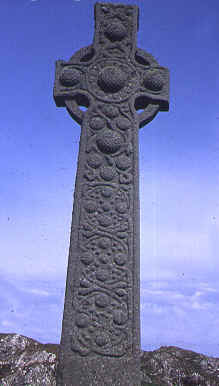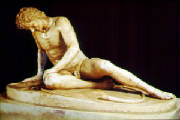|
An archaeological view of Celtic occupation in the British Isles

|
| Celtic Cross on the Island of Iona in Scotland |
The Celts have widely been known for their art, their fighting habits, and their unique adaptation into Christianity. Over
the centuries, not much has been known about these ancient peoles since they had no written language. All of what we know
today come from the archaeological record and what was written about them in Classical literature, as well as by their christian
descendents.

|
| A copy of a Classical sculpture called "The Dying Gaul" |
The Celts were known for their unique fighting styles. For example, they would often times run into battle, stark naked,
with a look of madness in their eyes. Although this was intimidating enough, often times some warriors would 'change appearance.'
This transformation was called the warp-spasm.
|

